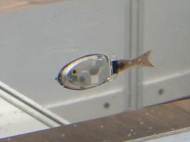Robotic fish consume less power by using magnets instead motors
 We already wrote about several projects related to robots inspired by fish as the MIT robot fish from or the fish robots contracted to search for pollutants in the waters. The robotic fish, special because it uses only a fraction of energy needed to swim through the water, is being developed by the Faculty of Engineering at Osaka City University. It was displayed on this year’s FC Expo (a conference dedicated to hydrogen power and fuel cells).
We already wrote about several projects related to robots inspired by fish as the MIT robot fish from or the fish robots contracted to search for pollutants in the waters. The robotic fish, special because it uses only a fraction of energy needed to swim through the water, is being developed by the Faculty of Engineering at Osaka City University. It was displayed on this year’s FC Expo (a conference dedicated to hydrogen power and fuel cells).
The unnamed robot fish, which is 10cm long, can move very realistically. Aside propelling through the water, it is able to dive and rise, by changing the center of gravity of its sinker device. The developers first used a motor but scrapped that idea later when they found out power consumption stood at 1W.
Afterwards, they came up with a solution by using magnets which pushed down that number to 10 milliwatts. They managed to achieve lower consumption by using a neodynium magnet inside a coil with about 3,000 turns. When electric current is passed through the coil, the magnet moves sideways thus enabling fish-like movement.
The small robot fish is using a lithium polymer battery. They also developed a larger prototype robot fish with a built-in fuel cell, but they haven’t demoed it on the expo due to the safety reasons. The solid-polymer fuel cell dubbed “Power Tube” uses hydrogen peroxide to supply oxygen even under water.
Their final goal is to develop a robot fish that’s able to swim for three consecutive days on a single charge. The robot fish’s motion can be programmed, and more complicated motions can also be specified. In the future, the research group is considering applications such as rescue work and marine resource surveys by building a camera into the robot.









It’s great they achieved a 100 times lower consumption, but I doubt it will be able to perform outside the controlled environment of the water tank.